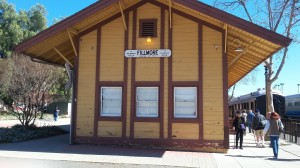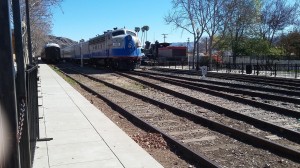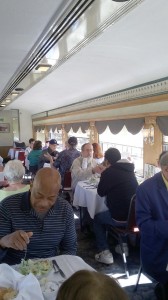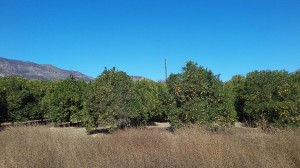THE FILLMORE & WESTERN RAILWAY
THE FILLMORE & WESTERN RAILWAY
By Charles N. Stevens
Photos by Dolores Seidman
We wait by the old Fillmore station for our train. Its locomotive is close by, its headlight beaming, its diesel engines idling in a haze of smoke. The crowds gather as boarding time is near. We still have time to look at the old yellow railroad station originally built by the Southern Pacific Railroad in 1887 when the present railroad was once the main line between Los Angeles and San Francisco.
The excitement mounts as the train approaches in a cloud of exhaust smoke. The locomotive and the coaches, painted pale blue and white, roll slowly past us then eventually back into the boarding area. As we are part of a day tour, we board first. We find seats in the dining car, the tables covered with white linen, a fresh salad at each place. This is the first course of our lunch, the entree to be served as the train travels through the valley. The train generally travels from Fillmore to Santa Paula, but due to track work, we will have to stop midway.
Rolling along slowly through the orange and avocado groves is very pleasant and relaxing. The orange trees are loaded with fruit, some of it scattered on the ground. We wondered whether those oranges were good for anything. I am surprised to see so many avocado groves, thinking that they must have taken out some of the old orange groves to make way for the avocados that perhaps sell better. Among the groves stand high silver poles supporting large propellers used to mix the air, preventing freezing temperatures from damaging the fruit on cold mornings. Everywhere avocados hang on the trees, making me think about guacamole and avocado sandwiches.
After the salad plates are picked up by the waiters, the entrees are served. Today it is chicken breast, mixed vegetables and pilaf. It is so satisfying to sit back on the train as we dine and gaze out at the scenery of the Santa Clara River Valley. We pass by lemon groves so slowly and closely that we feel if the window glass were not there, we could reach out and pick the fruit. . We roll by acres of tree farms, with varied kines growing in wooden boxes. Rainbird sprinklers spray moving curtains of water, looking like waltzing dancers as they irrigate fields of growing lettuce and broccoli. At all times we are conscious of the mountains on all sides of the valley. The scene makes me think of Shangri La.
The dining car itself, an excellent remodeling of an old coach, is very clean and comfortable. The meals are cooked in a kitchen right on the train.
Our train stops at a sort of farmers market called the Loose Caboose. Here we detrain and board our waiting bus that will take us to Santa Paula, the trains usual destination, but more about Santa Paula in the next article.
The tracks our train uses, formerly owned by the Southern Pacific are now owned by the Ventura County Transportation Commission, but the train is owned by the Fillmore & Western Railway. It’s somewhat confusing.
Once we have finished our tour of Santa Paula, our waiting bus takes us down Highway 126, past our starting point at Fillmore and on to an area near Piru. The train has backed up to this point, a place near the tracks called Bennett’s Honey Farm. If you don’t mind crowds cooped up in a small sales room, you can buy honey of all kinds.
We board the train again, finding a generous slab of carrot cake on each table. We enjoy the cake as the train heads back to Fillmore. This will be a different section of tracks with views we haven’t seen before. We cross the highway then roar through a short tunnel and the citrus groves beyond.
Many movies and television programs have used the Fillmore & Western Railway for their productions. Among the movies shot on the railroad are Seabiscuit and Get Smart. Television programs produced on the trains are CSI and Criminal Minds.
The railroad offers special trains such as Murder Mystery Dinner Trains, Weekend Excursion Trains, Easter Sunday Lunch trains as well as the Steam Rail Fest that features trains powered by steam locomotives. The railroad owns two of them.
Still working on our cake we again roll through the citrus and avocado groves as well as fields of greening vegetables. With the locomotive bell clanging, we slowly move through the rail yards with their rolling stock of freight and passenger cars and locomotives, then into the Fillmore Station. We’ve had a wonderful outing on a beautiful day, but it’s time to board the bus for the trip back home.

The Fillmoe station was built in l887 when the tracks were on the main route between Los Angeles and San Francisco.

Our train, its locomotive idling, is about to roll into the station.

We eat our first course in the remodeled dining car.

We pass through miles of orange, lemon and avocado groves.
MONTEREY PARK AUTHOR PUBLISHES 4th BOOK – Seeking More of the Sky: Growing Up in the 1930’s:
Charles “Norm” Stevens, a 43 year resident of Monterey Park has recently published his 4th book: Seeking More of the Sky: Growing Up in the 1930’s. This is the story of a young boy growing up in Inglewood, California in the l930’s. This was a time during the depression when unemployment was affecting many and the banks were closed, while the clouds of war were gathering in Europe. But he was lucky enough to be raised in a loving family, the power of that love reflected throughout his stories.
Stevens is the author of three previous books about his experiences during WWII:
An Innocent at Polebrook: A Memoir of an 8th Air Force Bombardier (Story of his 34 bombing missions from his base at Polebrook, England over Germany and France)
The Innocent Cadet: Becoming A World War II Bombardier (A prequel to the first, telling of his training in the U.S. before going overseas into combat.)
Back from Combat: A WWII Bombardier Faces His Military Future from Combat: (This book details the time from when he returned from combat in England until the end of the war.)
He is known to the readers of The Citizen’s Voice as the author of Travel Log Articles including “Cruising the Rhine and Mosel”,” Best of the West”, “In Search of Snow” , “From Paris to Normandy on the Seine”, and “Exploring New York”. He is retired, having taught for 32 years, primarily in the Montebello Unified School District.
Those interested in purchasing an autographed copy of any of his books, may contact the author at 323-721-8230 or Normstevens24@gmail.com.



